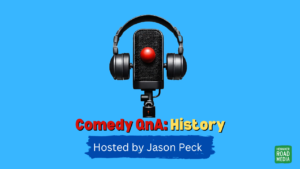I was inspired to write a companion piece to an article that Lisa Braithwaite published over at Speak Schmeak – rewards of ending on time. If you haven’t checked it out, make sure that you do.
I wanted to talk about my own experiences with speech timing and also provide some some tips on funny presentations.
When I first started with Toastmasters my first few speeches overran greatly. So this was an issue that I clearly needed to address. I had way too much content and wasn’t spending enough time timing it.
It’s not about you, it’s about them
As some who gives funny presentations, not only should you take into consideration the length of time that you’re speaking for and how overrunning may affect others, but you need to take the audience’s laughter into consideration.
Working at a high level, stand-up comedians, for example, achieve a positive audience response (PAR) of 30 or above. PAR includes laughter, applause and so on; any positive response. So this translates to somewhere around 15-19 seconds of laughter per minute.
If a comedian uses the least amount of words possible, whilst maintaining the level of laughter, then they have the ability to rock the majority of audiences.
How to be “on fire” as a speaker
Speaking professionals, on the other hand, who are delivering funny presentations don’t have to achieve anywhere near that number in order to be considered a fantastic humorous entertainer.
A funny speaker need only attain a PAR score of 15, which is 45 seconds of laughter for each 5 minutes of presenting; or 9 seconds of laughter for every minute.
From a personal perspective I always try to shoot for a PAR of 20-30 because then I know that I fall short of that target I am at least over-delivering on the humorous aspect, making sure that I don’t sacrifice my message obviously.
So if you’re presenting for 20 minutes I would under run by about 3 minutes to allow for possible laughter pauses. If that amount of laughter doesn’t come, it’s still better to under run than overrun.
You should also take into consideration the timings of a Q&A session if you’re expected to deliver one. The speaking part of your presentation would then need to be adjusted accordingly.
A Stopwatch can be your friend
Just as Lisa said, grab yourself some sort of timing device and practice giving your presentation beforehand and timing it. It’s essential as it can throw out the rest of the event.
Go over your speech or presentation and then go over it again. Don’t forget to allow time for changing slides. Also, practise with your equipment if you can as something might go wrong and you’ll need to get it fixed and that all adds time.
Just because you lose ten minutes through faulty equipment that doesn’t mean that you still deliver your presentation with the amount of time that you had originally planned. No, no, no, you’re going to have to think on your feet and cut it short. The event planners will thank you and so will your audience, especially if you’re eating into a break.
I’ve seen speakers disqualified during Toastmasters contests because they overran. It’s such a schoolboy error especially because the Toastmasters system is geared towards you being able to manage your time effectively.
I’ve even seen it happen at high levels of a contest and you just think “the speech is great and everything but that red light has been on for far too long now”. It’s surprising how oblivious a speaker can be.
Not only should your speech content be geared towards your audience, but whole presentation needs to take them into consideration too. Knowing who spoke before you, what what activity took place and what’s going to happen after you (another speaker, some sort of activity or lunch) is vital.
I helped to run a week long series of presentations for medical professionals in November 2008. It’s sometimes good to be able to experience an event from the other side. Nearly all the speakers overran, despite them being medical professionals themselves and accomplished presenters.
It got so bad that I had to indicate to the presenters that they needed to wrap things up. Makes the whole event look a bit unprofessional.
So when you’re giving a funny presentation make sure you’ve got your timing down – both of the speech content and your comic timing.
Use this link if you want to learn more about PAR scores and the tools I gained from learning stand-up comedy



